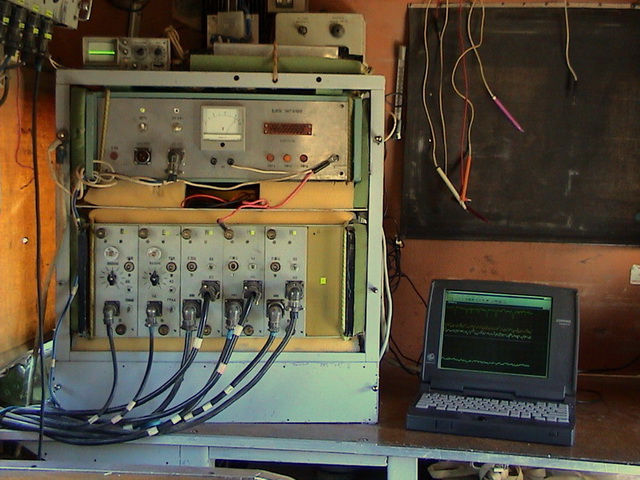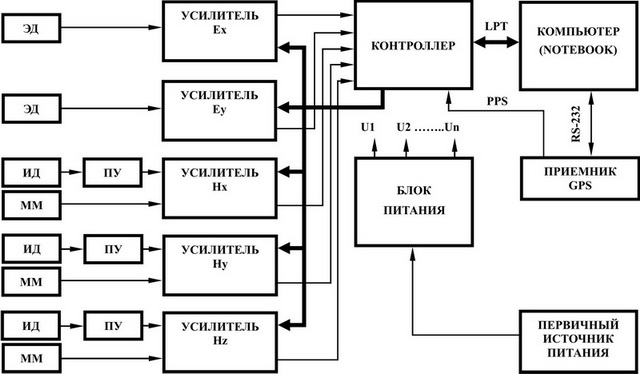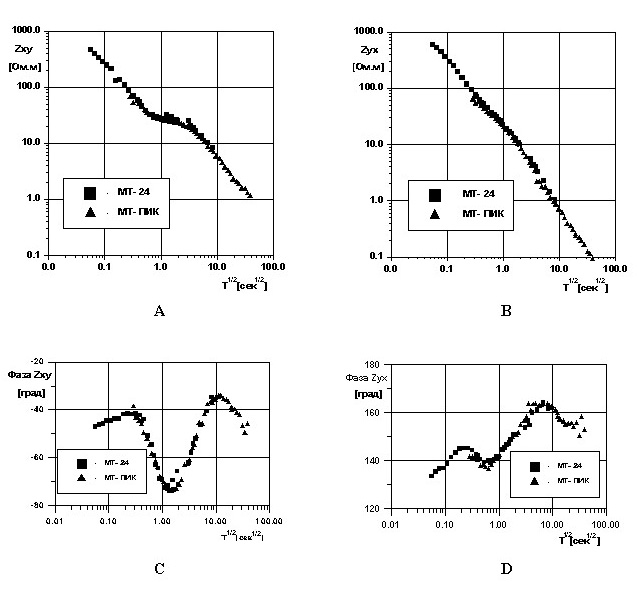2. Digital Measuring Complex MT-PIK
In 1996-1998, the Research Station RAS created a hardware/software system for electromagnetic measurements by magnetotelluric and magnetovariational soundings. We developed and made two sets of equipment (fig.2) successfully tested in field conditions in 1998-1999.

Fig. 2
Field magnetotelluric measuring hardware system (MT-PIK) is intended for digital recording and processing of five components of the Earth’s electromagnetic field. Field recording and processing give the components of impedance tensor and magnetovariational matrix in observation site. The system can be applied in studies of the structure of the Earth’s crust, and in search and exploring the electrically contrasting mineral deposits.
The measuring complex is intended for field works and is placed in the wagon. Several measuring complexes provide synchronous recording of magnetotelluric field. Works are synchronized by the sensor of exact time (GPS-receiver).
Measuring complex MT-PIK includes:
- Unit of measuring amplifiers.
- Recorder (controller) with built-in ADC.
- Set of magnetotelluric field sensors.
- Power system (accumulator unit, unit of solar panels, hardware power unit).
- Sensor of exact time (GPS-receiver).

Fig. 3 Functional diagram of measuring complex MT-PIK
The complex has five basic and five complementary channels (not shown in the figure). Five measuring amplifiers are attached to basic channels. Any other amplifiers or sensors can be attached to the five complementary channels.
Electric dipoles serve as sensors of electric components of field Ex and Ey. As electrodes of dipoles, we use specially made nonpolarizable electrodes based on carbon, which is placed into pressed powder of manganese-carbonic mixture.
Static magnetovariometers (MM) and inductive sensors (ИД) serve as sensors of magnetic components of field Hx, Hy, and Hz. Magnetovariometers are used for long-period recordings. Inductive sensors record signals in mid-frequency and high-frequency ranges. Inductive sensors have preamplifiers installed in immediate proximity to them.
Along with electric dipoles (ЭД), we use amplifiers of electric channels (amplifier Ex and amplifier Ey). Along with magnetovariometers and inductive sensors, we use appropriate preamplifiers (ПУ) and amplifiers of magnetic channels (amplifiers Нх, Ну and Нz).
Amplified signals of sensors enter the controller, where the analogue-digital converter converts them to digital form. Then they enter the external computer (Notebook) for storing and further processing.
The controller also controls the parameters of amplifiers (initial balancing of bias voltage, regulation of amplifier coefficient, connection and disconnection of inductive sensors or magnetovariometers in magnetic channels, frequency switching of low frequency filter cuts in measuring channels, turning the high frequency filter in electric channels on and off). Besides, the controller regulates the frequency of analogue signal sampling. The controller is connected to the external computer by bi-directional bus of parallel port (LPT – standard interface).
To ensure the synchronous functioning of measuring complexes, the hardware provides the application of GPS-receiver connected to the external computer by a standard interface RS-232. The receiver generates time-markers of seconds (PPS) to the controller.
Power unit supplies power to all units and devices of measuring complex. As buffer power source, the measuring complex employs a rechargeable battery of capacity 420 A.h. and voltage 12V, which is recharged from solar panels or through a special charger of gasoline-electric unit. The external computer is also powered by a rechargeable battery.
The measuring complex has three modes of signal recording: “RABOTA” (operation), "GR/ET" and "ChH". “RABOTA” records magnetotelluric field. "GR/ET" records calibrated (graduated) and basic precise signals. "ChH" records signals used in calculation of amplitude-response curves and phase-response characteristics of measuring channels.
As well as the famous electromagnetic prospecting system TsES-2 developed by the VNII “Geofizika”, the measuring complex MT-PIK has three types of operations: low-frequency-, mid-frequency- and high-frequency magnetotelluric soundings, intended to record magnetic field, correspondingly, in low-frequency range (0 ÷ 0,1Hz), in mid-frequency range (0,1 ÷ 1,0Hz) and in high-frequency range (1,0 ÷ 10Hz). Frequency characteristics of channels are switched depending on type of operation and frequency range of recording. Switching is done by changing sensors of field, changing frequency of cut of low frequency filter and switching on the filter of high frequencies (only for electric channels). Besides the filter of low frequencies, every measuring amplifier has a rejecter, which rejects signals of man-made statics at a frequency of 50 ±1 Hz.
In summer 1999, within the framework of international project “Geodynamics of Tien Shan” we conducted a sufficient part of soundings using foreign magnetotelluric stations. In the southern side of Kochkor depression, we conducted measurements along a continuous (approx.6 km) profile of high resolution using a wide-band American station MT-24 (EMI). It is important that during given field experiment we compared measurements taken by different tools. To compare the equipment and technology of measurement and processing, we conducted joint measurements using two stations MT-PIK and MT-24 at two sites of profile. Comparison of obtained impedance curves (fig.4) showed their good match in the working range of periods of MT-PIK (within the bounds of inaccuracy of determining the impedance). Field data was processed by the program of Alan Chave.

Fig. 4
Since 1999, magnetotelluric measuring stations MT-PIK have been widely used at filed works carried out by MTZ group of the Laboratory of deep magnetotelluric investigations of the Research Station RAS. Using these stations we have conducted magnetotellutic soundings of the Earth’s crust in more than 200 sites in Kyrgyzstan and Kazakhstan. Using the obtained data, we shaped the models of deep electric cross-sections of the Earth’s crust of the investigated Tien Shan region related to geodynamic and seismic processes in the given region.






